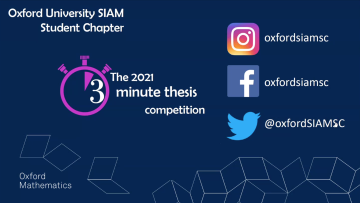North Meets South
Abstract
Jaclyn Lang
Explicit Class Field Theory
Class field theory was a major achievement in number theory
about a century ago that presaged many deep connections in mathematics
that today are known as the Langlands Program. Class field theory
associates to each number field an special extension field, called the
Hilbert class field, whose ring of integers satisfies unique
factorization, mimicking the arithmetic in the usual integers. While
the existence of this field is always guaranteed, it is a difficult
problem to find explicit generators for the Hilbert class field in
general. The theory of complex multiplication of elliptic curves is
essentially the only setting where there is an explicit version of class
field theory. We will briefly introduce class field theory, highlight
what is known in the theory of complex multiplication, and end with an
example for the field given by a fifth root of 19. There will be many
examples!
Jan Sbierski
The strength of singularities in general relativity
One of the many curious features of Einstein’s theory of general relativity is that the theory predicts its own breakdown at so-called gravitational singularities. The gravitational field in general relativity is modelled by a Lorentzian manifold — and thus a gravitational singularity is signalled by the geometry of the Lorentzian manifold becoming singular. In this talk I will first review the classical definition of a gravitational singularity along with a classification of their strengths. I will conclude with outlining newly developed techniques which capture the singularity at the level of the connection of Lorentzian manifolds.
North Meets South
Abstract
Clemens Koppensteiner
Categorifying Heisenberg algebras
Categorification replaces set-theoretic structures with category-theoretic analogues. We discuss what this means and why it is useful. We then discuss recent work on categorifying Heisenberg algebras and their Fock space representations. In particular this gives a satisfying answer to an observation about equivariant K-theory made by Ian Grojnowski in 1996.
Aggregation-Diffusion Equations
David Gómez-Castro
The aim of this talk is to discuss an evolution problem modelling particles systems exhibiting aggregation and diffusion phenomena, and we will focus mostly on the so-called Aggregation-Diffusion Equation: ∂ρ ∂t = ∇ · (ρ ∇(U′ (ρ) + V + W ∗ ρ)) (ADE)
First, we will discuss the modelling. The famous case U′ (ρ) = log ρ and W = 0 is the famous Heat Equation. In the classical literature, the term U′(ρ) is typically deduced from Darcy’s law and models an internal energy of the system. We will show through particle systems how the term V models a confinement energy and W ∗ ρ an aggregation energy. The complete model covers many famous examples from different disciplines: Porous Media, Fokker-Plank, Keller-Segel and others. After this modelling, we discuss the mathematical treatment of (ADE). As in the case of the Heat Equation, the diffusion cases where W = V = 0 are typically studied in the Lebesgue and Sobolev spaces. However, as in the Keller-Segel problem, a Dirac measures may appear in finite time. We present the Wasserstein distance between measures, which is a natural framework for these equations, connecting with the theory of Optimal Transport. In fact, when U, V and W are convex, (ADE) can be studied as the gradient-flow of a free-energy functional (i.e. curves minimising this energy) in this Wasserstein distance, applying Calculus of Variations techniques. We will discuss the minimisation problem associated to F, with an interest to the existence of Dirac measures. Finally, we will present new results showing that indeed, in some cases besides Keller-Segel, states with a Delta can be achieved through solutions of the evolution problem
Ethics and responsible innovation - what is it and how does it affect our research in mathematics?
Abstract
How aware should we be of letting AI make decisions on prison sentences? Or what is our responsibility in ensuring that mathematics does not predict another global stock crash?
In this talk, Helena will outline how we can view ethics and responsibility as central to processes of innovation and describe her experiences applying this perspective to teaching in the Department of Computer Science. There will be a chance to open up discussion about how this same approach can be applied in other Departments here in Oxford.
Helena is an interdisciplinary researcher working in the Department of Computer Science. She works on projects that involve examining the social impacts of computer-based innovations and identifying the ways in which these innovations can better meet societal needs and empower users. Helena is very passionate about the need to embed ethics and responsibility into processes of learning and research in order to foster technologies for the social good.
A Short Introduction to the Fractional Laplacian
Structure: 1 x 2hr Lecture
Optimal Transport and Lower Curvature Bounds
Structure: 1 x 2 hr Lecture
To gain an insight in to mathematical student life under lockdown, we asked Oxford Mathematics and St Peter's College 2nd Year Undergraduate Matt Antrobus to provide us with one-minute updates over the course of last term.
So he did in a very personable and honest way, describing the maths he is doing, how he is doing it and how much work is involved. Matt also reflects on the stark fact that over half his time in Oxford has been under the cloud of Covid.
14:00
On generalised Nash equilibria and their application to pricing in the power market
Abstract
A link for this talk will be sent to our mailing list a day or two in advance. If you are not on the list and wish to be sent a link, please contact @email.



